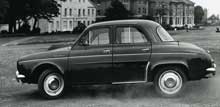The Princess Pirouettes
On March 6, 1956, Renault launched La Dauphine, The Princess, in Paris. It was to make Regie Nationale des Usines Renault a world-class manufacturer and give the company a major toehold in the United States.
Before World War II, Société Renault Frères had been a full-line manufacturer, making cars up to Chrysler-class with eight cylinder engines. When the country emerged from German occupation the new government nationalized the company and assigned it a small-car segment under a new industrial program. The bread-and-butter Renault was the 4CV, a four-door with 760 cc water-cooled engine at the rear. By 1949 it was available on the American market through John L. Green in New York. Not the best-selling import (that was the English Ford), it nevertheless gained a following.
In 1957, the Dauphine arrived in the new world, through a direct factory branch in New York City. It was a huge success, more than 22,000 sold, second only to competing upstart Volkswagen. With modern styling and four doors (but only three speeds) there was speculation that it would overtake the German beetle. La Dauphine was touted as smart, practical, economical, maneuverable, hospitable, safe and comfortable. The engine had been enlarged to 845 cc and 30 hp, and in 1960 a hotter version, breathed over by Renault's tuning partner Gordini, was introduced. It had 25 percent more power and a 4-speed box. A sporty Floride model (Caravelle in the US) joined it. The last front-engine-rear-drive Renault, the Fregate, was discontinued after 1959. That was Renault's peak year in America, with nearly 100,000 sold, within 30,000 units of VW. At the end of the model run, Henney Motor Company, the ambulance people, teamed up with Eureka, the vacuum cleaner manufacturer, to electrify some Dauphines, sold as Henney Kilowatts.
And then the slide began. A new R8 model in 1969 and its successor R10 were stubby and less attractive, though exceedingly comfortable. Sales slid below 23,000, and a shift to front-engine-front-drive for U.S. models in 1969 only briefly buoyed its popularity. In 1975, just 5,780 found American homes. Agressive marketing for the new Renault 5, sold as "Le Car" in the US, resulted in another resurgence, more than 25,000 by 1980. Addition of the new 18 model in 1981 helped, joined by a sports coupe derivative, the Fuego, in '82.
But the big news in '82 was Renault's purchase of a majority holding in struggling American Motors Corporation. Dubbed by some "Franco-American Motors," the alliance resulted in just that, the Renault Alliance, clone of the Renault 9, built in Wisconsin and sold by all AMC dealers. The 18 remained alongside it until the Chrysler buyout of AMC in 1987, which within a few years removed all Renaults and most AMCs from the American market.
Despite that rich heyday, Renaults of any kind are few and far between in today's collector community. While there are numerous gatherings devoted entirely to VW Beetles, you'll have to look long and hard to see any kind of Dauphine at an American car show.

